Dogs have many ways of letting us know something is up with their health.
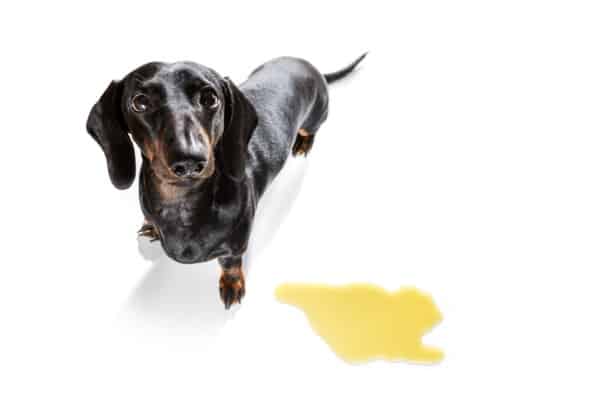
On the other hand:
They can’t tell us exactly what is going on the way another human can.
Then how can a dog let us know when there’s something different with their health?
This is where you, the pet parent, come in.
See also:
- Dog Peed on My Bed in Front of Me: Here’s What You Can Do
- Dog Leaking Urine When Lying Down: 7 Causes and What You Can Do Now
- Urine Scald in Dogs: 5 Best Treatments
- Dog Drinking Own Urine: 5 Causes and How to Stop It
- Is Dog Urine Harmful to Humans: Answers You Should Know
Dogs are creatures of habit, so when something changes in their normal behavior, it’s good to pay attention to the changes.
When it comes to urinary disorders and issues, you can figure out a lot by observing anything out of the ordinary.
From crystals to the presence of mucus after going “number one,” dark dog urine, or even foamy pee, the urine characteristics alone can be an important signal.
What causes crystals in dog urine? What are some symptoms to look out for? What do crystals in dog urine mean?
We’ll cover this in-depth and help you understand what the condition means for your beloved dog.
Diagnosing the Issue
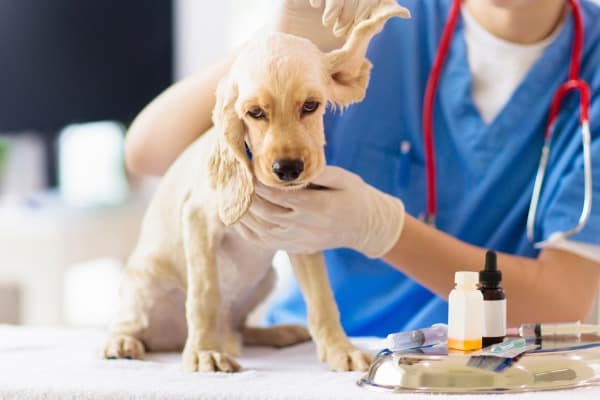
The only way to know if your dog has crystals in their urine is for a vet to perform a urinalysis.
This is a test not typically done unless there is suspicion of a problem.
So what to look out for, and what things should you inform your vet about?
Several symptoms can point toward crystals in the urine.
Dogs should be urinating 3-5 times a day.
If your dog typically goes no more than three times daily, and you’ve noticed that number climbing, it could be your first clue that something isn’t right.
Another thing to watch out for?
You might have to get a little nosy – but it’s helpful if you can determine if your dog is having trouble passing urine.
If the stream is irregular, or you notice signs of them straining, it could be because they have crystals in their urine.
A troubling symptom is the presence of blood in the urine. It might be less noticeable, causing the urine to be a pale pinkish color.
Drinking more water than normal is another thing to keep an eye on.
You might notice your dog going to the water dish more than usual or that you’re refilling it more often.
What exactly are urine crystals?
As the name implies, urine crystals are the formation of tiny crystalline structures that are not normally present in the urine.
Known as crystalluria, this condition can sometimes be a precursor to bladder or kidney stones.
Luckily, crystalluria does not guarantee these conditions will rear their heads.
Should you be concerned?
Even if they don’t go on to form kidney or bladder stones, they can make your dog uncomfortable and prone to urinary tract infections.
In some cases, they can cause bladder or kidney infections, which are a little more serious.
Try not to worry – especially if caught early, this condition can be treated in a number of ways. More on that soon.
Causes
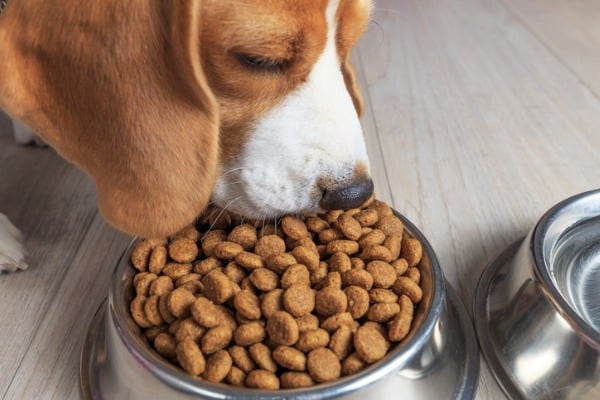
The big question you’ll be asking if a urinalysis detects this condition: what causes crystals in dog urine?
A common suspect is their food.
Any low-quality dog food can disrupt the pH levels in their system and provide the building blocks for this annoying condition.
What foods cause crystals in dog urine?
Foods with too many grainy fillers, carbs, or other starches are often the culprit.
If your dog gets too many table scraps, it could also be a contributing factor for an imbalance in their pH levels.
Certain dog breeds might be more prone to have crystals in their urine.
Several types of crystals can form; some breeds have a higher risk than others, depending on which kind is identified in the urine.
Calcium Oxalate Crystals
Yorkies, Mini Poodles, and Schnauzers, and Lhasa Apsos are more likely to develop this type of crystal.
Xanthine Crystals and Stones
Cavalier Spaniels, Dalmatians, and English Bulldogs are known to have crystals that can turn into Xanthine stones.
Cystine Crystals
Newfoundlands, Dachshunds, Mastiffs, and, again – English Bulldogs – have a higher risk for this kind of crystals.
Another type that can form is the struvite crystal, which in low quantities, is normal. However, if there are too many of them, they can cause issues for your dog.
Aside from a urinalysis, the vet might perform an X-ray or ultrasound on your dog to better understand the type and severity of the crystals.
Different crystals can also lead to varying types of bladder stones.
There is no one-size-fits-all solution for bladder stones or crystals, so figuring out what they’re made of is essential in treating them.
Are there any other reasons for crystals to form?
Regardless of breed, some dogs have genetic disorders that make their bladder a prime environment for urine crystals.
Some medications can also cause this issue, which vets should inform you about upon prescribing them.
Treatment
Kids, Don’t Try This at Home
The presence of crystals in the urine might not mean your dog will develop a bladder stone.
To decrease those odds even further, it’s important to seek treatment for your dog as soon as the condition is diagnosed.
So what is the best treatment for crystals in dog urine?
While treating crystals in the urine is something you can do from home, getting an accurate diagnosis from your vet before starting any treatment plan is essential.
Since you can’t know for sure what type of crystals your dog has, you can’t understand the adjustments to make in their diet – or if they need prescription medications.
You might make the condition worse if you try to diagnose it yourself.
But Do Try This at Home
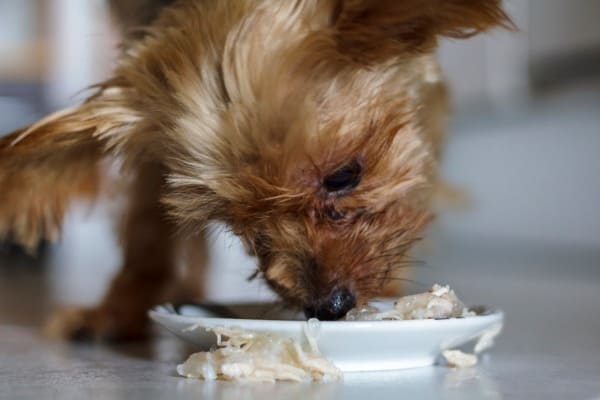
Most types of crystals form because of an improperly balanced pH level.
In this case, adjusting your dog’s diet is often the only solution.
The Right Food
Should you try a special dog food for urinary crystals?
You most certainly can once the type of crystals are identified.
Some varieties might indicate the pH is too acidic, while others are present because it’s too alkaline.
In either case, adjusting the diet in one direction or the other can be very helpful.
While specific brands of dog foods don’t matter, you’ll want to stay away from cheaper ones with low nutritional value.
Check out our recommended list of urinary care dog food to get you started.
Depending on which type of crystals your dog has, you might need to increase or decrease the protein percentages in their diet.
A vet might also recommend the addition of wet food or to feed your dog only wet food instead of dry kibble for a period of time.
More Water
Increasing their water intake might also be recommended. You can’t force your dog to drink more, but you can encourage it.
Adding water to their dry food or enticing them with “dogsicles” are easy ways to sneak more water into their routine.
Homemade popsicles for dogs are easy and cheap – low-sodium broths with some enticing snacks in the mix can be frozen in an ice tray or popsicle mold.
Some dogs are happy with an ice block that has a tasty morsel of food inside.
Lean meat at the core of the “dogsicle” is often enough to get them to lick up the melting ice to get to the treat.
It might sound gross to us, but most dogs love it.
As an added benefit, it’ll keep them occupied for quite a while.
Just be sure to feed these to your dog outside or on an easily cleaned surface – they can be a messy snack.
Why is this important?
Let Them Go…Potty
While your dog’s diet should be helping prevent new crystals from forming, getting the existing ones out is vital.
Urinating often and fully voiding their bladder is incredibly helpful in flushing out those nasty crystals sooner rather than later.
In other words, don’t make your dog hold their pee any longer than necessary during this treatment phase.
Make sure they have as much water as they can drink, and don’t rush them when they need to eliminate them.
If your dog refuses to go pee outside, they might still be trying to tell you something.
Getting their pH levels back on track might require some dirty work if you don’t want to make frequent trips to the vet.
Test strips that measure the pH levels in your dog’s urine are available online, in pet stores, and in the vet’s office.
It might not be a pleasant task, but it’s a good way to see if things are working before the vet wants to see your dog for a follow-up appointment.
When you buy those pH strips, it’s best to buy yourself a box of sterile gloves, too – just to eliminate some of that “yuck” factor.
In some cases, your vet might prescribe medications to help get your pup back on the road to normal.
Potty Business
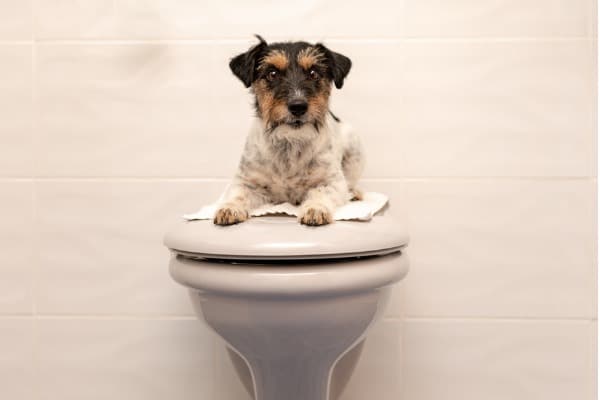
Hopefully, it’s no shock to you that some parts of pet parenting can be a little hands-on and dirty.
Now you know what causes crystals in dog urine, you can be prepared for it.
Keeping a close watch on your dog’s bathroom habits is a great way to pick up on abnormal changes that require attention.
This can include any foul or fishy urine smell or even your dog smelling like urine!
What if your dog is diagnosed with urine crystals? Try not to panic.
Although no one wants to see their baby uncomfortable, it’s rarely a cause for alarm – and almost always something you can help cure at home with a vet’s guidance.
But overall, treatment for crystals in dog urine is fairly straightforward once you know what you’re dealing with.
Things to prepare for?
Some diagnostics at the vet, changes in dog food, and giving a little extra love while your pet regains their health.
